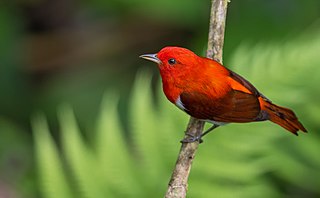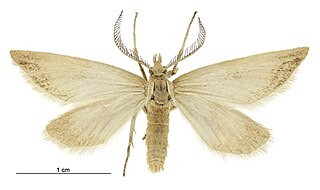
The scarlet-and-white tanager is a species of bird in the family Thraupidae. It is found in Colombia and northern Ecuador. Its natural habitats are subtropical or tropical moist lowland forests and heavily degraded former forest. The male is highly distinctive and has bright scarlet upperparts, darker red wings and undertail coverts, and white underparts with a scarlet median stripe running down the throat and belly. Females are patterned like the males, but are olive-brown instead of scarlet.
Diadegma agens is a wasp first described by Henry Keith Townes, Jr. in 1964. No subspecies are listed.

Antiscopa epicomia is a moth in the family Crambidae. This species was first described by Edward Meyrick. It is endemic to New Zealand and can be found throughout the country including on Auckland Island, Campbell Island, and the Kermadec Islands. It inhabits native forest, preferring damp, shaded forest ravines. Adults are variable in size and colouration and are on the wing all year but most frequently from October until March.

Asaphodes campbellensis is a species of moth in the family Geometridae. It is endemic to Campbell Island in New Zealand.
John Tenison Salmon was a New Zealand photographer, entomologist, academic, conservationist, and author. His primary occupation was as an entomologist; first at the Dominion Museum and then at Victoria University College.

Keith Arthur John Wise, often referred to as K. A. J. Wise, was a New Zealand entomologist. Originally employed at the Department of Scientific and Industrial Research, Wise began working with the Bishop Museum in the early 1960s, coordinating field programmes for United States visits to Antarctica and Subantarctic islands. This work led Wise to identify and describe large numbers of novel species, including many species of springtail. In 1965, Wise became the first Curator of Entomology at the Auckland War Memorial Museum, where he was integral in creating the first entomology section within the natural history gallery.

Acanthomurus rivalis is a species of springtail belonging to the family Isotomidae. The species was first described by Keith Arthur John Wise in 1964. The species is native to Campbell Island in the New Zealand Subantarctic Islands.
Alloecentrella is a genus of caddisflies belonging to the order Trichoptera. The genus was first recognised by Keith Arthur John Wise in 1958.
Alloecentrella magnicornis is a species of caddisfly belonging to the order Trichoptera. The species was first described by Keith Arthur John Wise in 1958, and is endemic to New Zealand.

Cryptopygus campbellensis is a species of springtail belonging to the family Isotomidae. The species was first described by Keith Arthur John Wise in 1964. The species is native to Campbell Island in the New Zealand Subantarctic Islands.

Friesea litoralis is a species of springtail belonging to the family Neanuridae. The species was first described by Keith Arthur John Wise in 1964. The species is native to Campbell Island in the New Zealand Subantarctic Islands.
Cryptopygus cisantarcticus is a species of springtail belonging to the family Isotomidae. The species was first described by Keith Arthur John Wise in 1967. The species is native to the Cape Hallett area of Northern Victoria Land in East Antarctica and the surrounding offshore islands, including the Balleny Islands.
Tullbergia mediantarctica is a species of springtail belonging to the family Tullbergiidae. The species was first described by Keith Arthur John Wise in 1967, and is only known to occur around the Shackleton Glacier area of Antarctica.

Parakatianna is a genus of springtails in the family Katiannidae. The genus was identified by Herbert Womersley in 1932.
Pseudosorensia atlantica is a species of springtail belonging to the family Isotomidae. The species was first described by Keith Arthur John Wise in 1970, and is found in South Georgia.
Tullbergia templei is a species of springtail belonging to the family Tullbergiidae. The species was first described by Keith Arthur John Wise in 1970, and is known to occur in Australian Subantarctic Islands such as Heard Island and Macquarie Island.
Friesea tilbrooki is a species of springtail belonging to the family Neanuridae. The species was first described by Keith Arthur John Wise in 1964. The species was first described by Keith Arthur John Wise in 1970, and is found in South Georgia and other Subantarctic islands including Bouvet Island, Heard Island and Macquarie Island.

Costachorema notopterum is a species of caddisfly belonging to the family Hydrobiosidae. The species was first described by Keith Arthur John Wise in 1972, and is endemic to the Auckland Islands of New Zealand.
Eupodes wisei is a species of mite belonging to the family Eupodidae. The species was first described by Herbert Womersley and Russell W. Strandtmann in 1963, and is found in Victoria Land, Antarctica.
Zelandanura is a monotypic genus of springtail belonging to the family Neanuridae. The sole species found in this genus is Zelandanura bituberculata. Both the genus and species were first described by Louis Deharveng and Keith Arthur John Wise in 1987. Zelandanura is endemic to Campbell Island in the New Zealand Subantarctic Islands.









